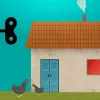Take a look inside 5 images
Homes by Tinybop
Pros: Impressive interactive elements and details engage and empower kids.
Cons: Controls and navigation can be a bit tricky.
Bottom Line: Offers a delightful and accessible way for kids to learn about the world's cultures.
Teachers could use Homes by Tinybop to kick off a unit on other cultures or on homes, letting kids explore and develop their own questions for learning. The app would be useful for a class of ELL students or a dual-language classroom because of the number of language options available. With tags turned on, kids can easily change languages and learn a bit of vocabulary in English, Spanish, French, German, and Chinese. Students could then choose a different region to research, either individually or in small groups. They could write about the people they think live in each home or discuss how their homes are similar and different. Teachers could also use the home tours with a mini-lesson on inference, showing kids how they can infer things from what they observe in each home. The Dashboard includes a handbook with more ideas, and the News section includes some lesson plans.
Homes by Tinybop is an interactive tour of homes around the world, in which kids see how other people live, eat, sleep, and play. It's all a discovery process with no instructions, so kids are free to explore on their own. Starting from a world map, kids choose to explore a home in the United States, Guatemala, Yemen, or Mongolia. They can view the home from the outside, or get an x-ray-like view of the interior and then enter and explore each part of the home by tapping where they want to go. Kids see the types of foods the people who live in the homes eat, and even get to prepare some of it. They can explore bathrooms -- some aren’t inside! -- and see how laundry is done. Kids can explore freely, or teachers can use the handbook in the Dashboard section for background information or to reveal some of the interactive elements.
Kids learn about cultures around the world, seeing what homes look like, inside and out, and what the people eat. They can make inferences about the people based on what they see in the homes -- how the residents spend their free time, how they do chores, and the conveniences they enjoy. The handbook offers more detail about the homes, the culture, and the architecture as well as thought-provoking questions. Using the tags in different languages, kids can also practice learning another language or simply developing their vocabulary.
The message -- there are many ways to make a home -- is lovely. The cultural education kids get is important. The fun and surprising interactive features are engaging. But it's the attention to detail that amazes! Subtle background noises hint to what's going on around each home -- for example, sirens and honking cars in the Brooklyn brownstone, chirping crickets and singing birds in the Guatemalan adobe home. Interactive features seem almost endless -- wash dishes, read books, play with toys, sew clothes, prepare food, play records, use the bathroom, and more. It's not perfect, though. Controls are a bit tricky, especially for little hands, so kids may miss some of the fun and learning trying to figure them out.












